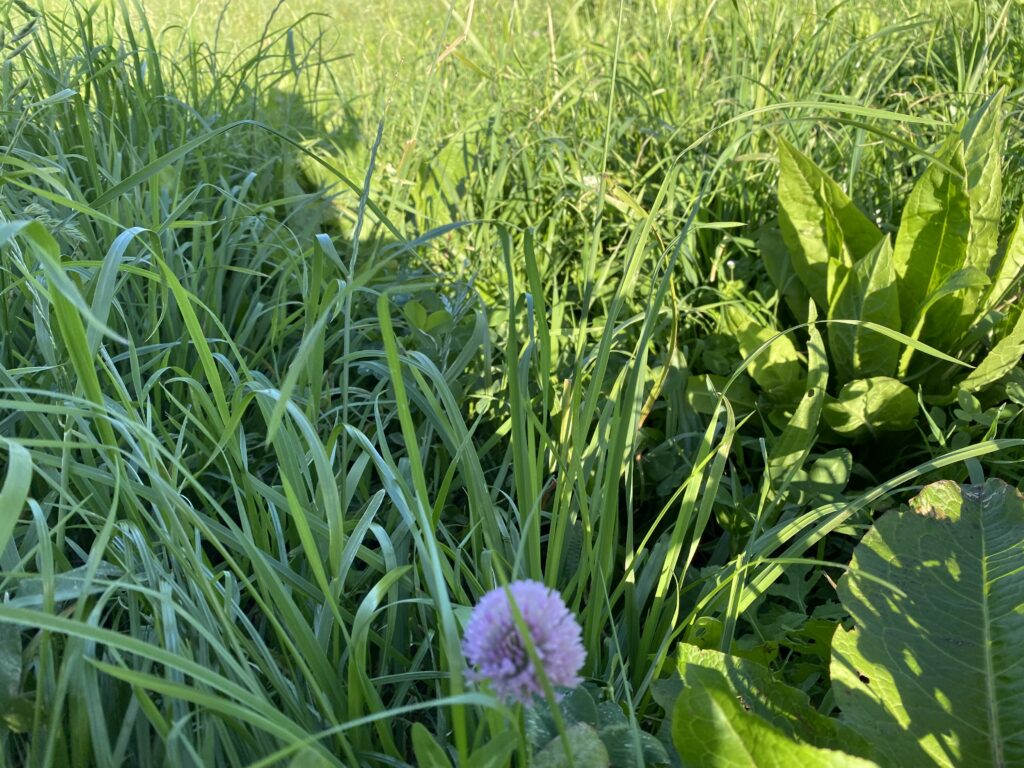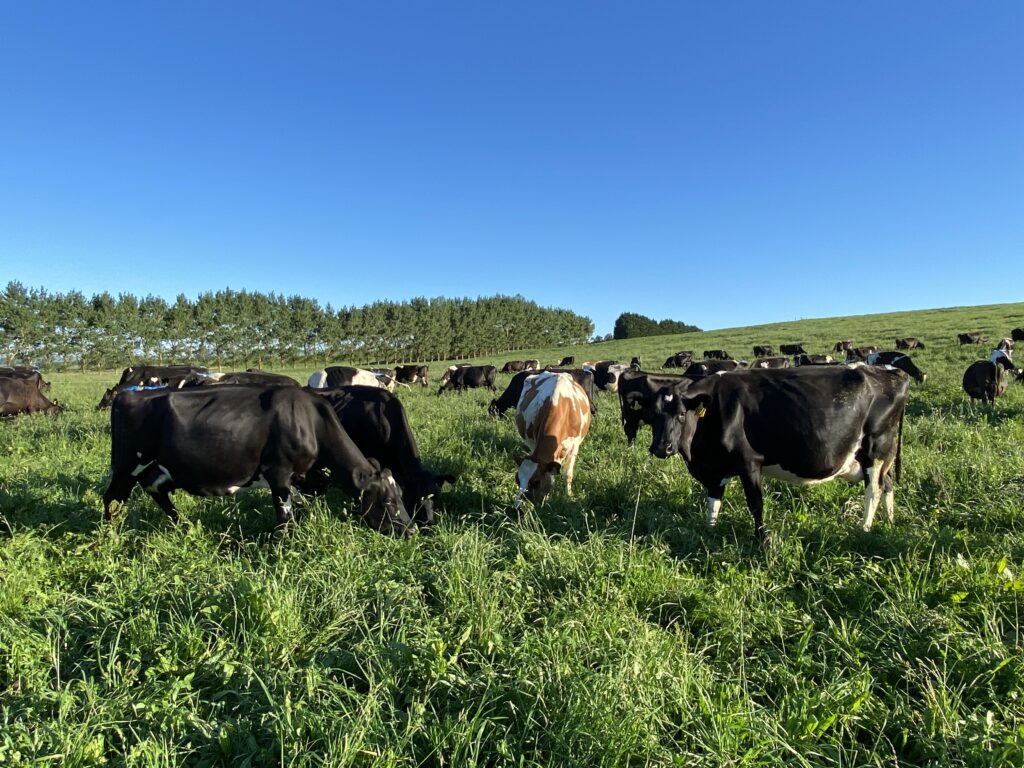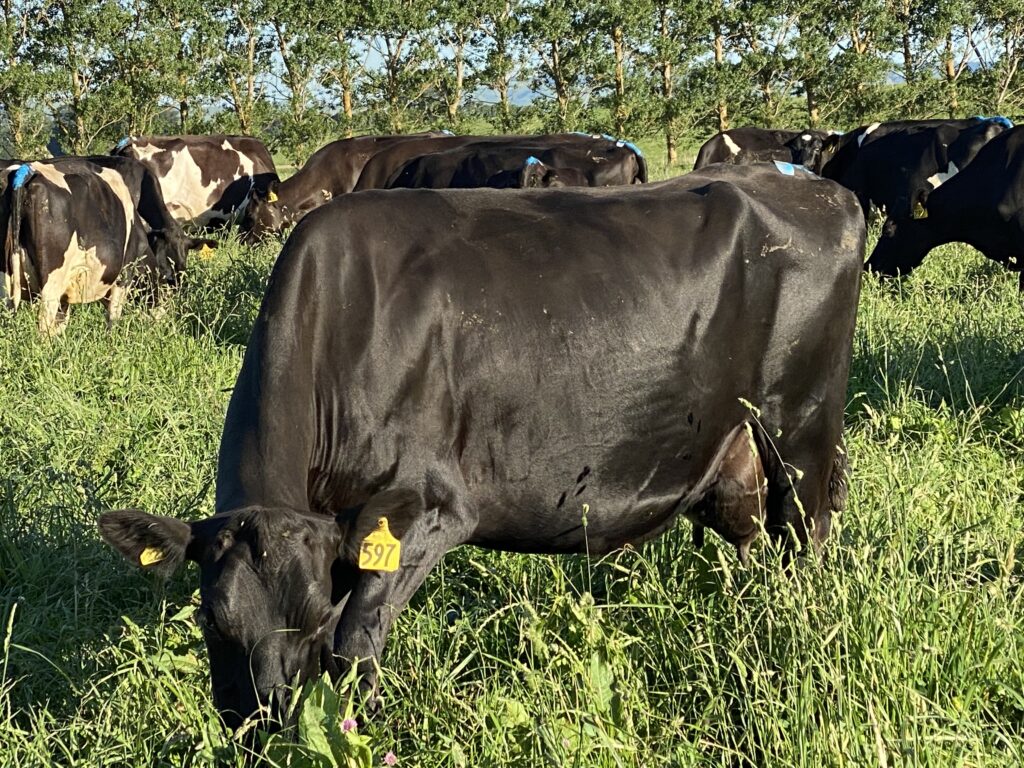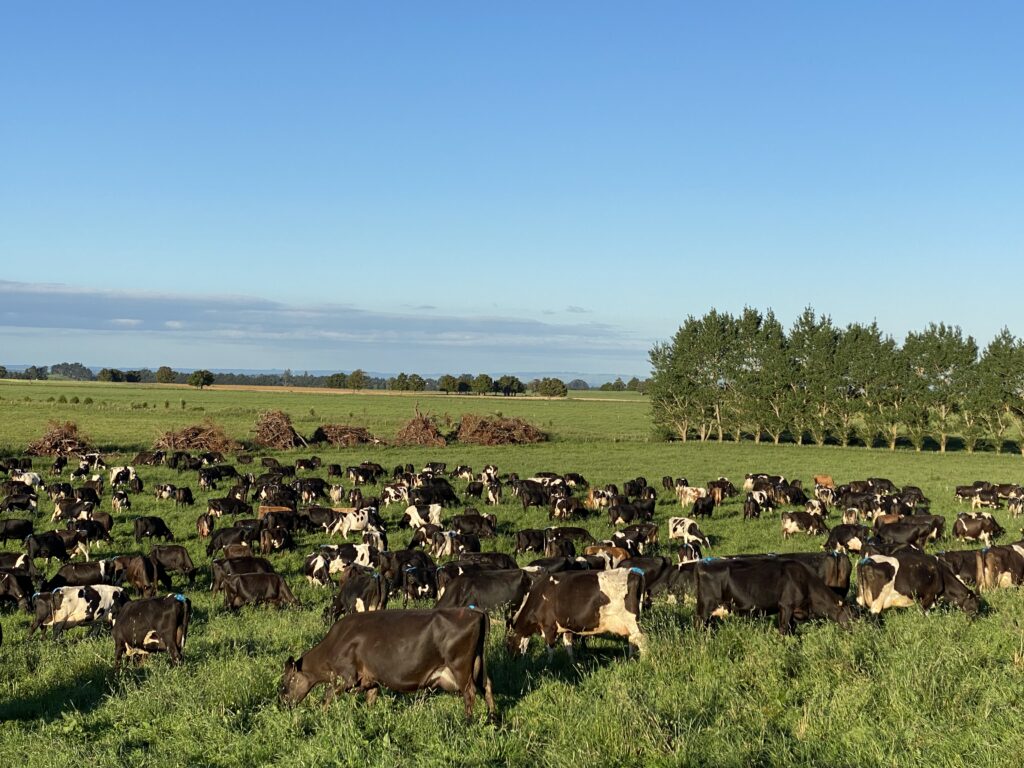Incorporating a holistic grazing plan allowed us to keep liquid carbon flowing and to substantially increase soil organic carbon levels
I took my first baby steps on my regenerative farming journey in 1989. My husband and I were subdividing a heifer pasture on the 240-cow conventional dairy farm we managed in Connecticut. I had talked the owner into letting us experiment with higher grazing density with the heifers.
We were pounding in cedar posts to string up barbed wire like all the other fences when our first farmer mentor, Michael Dwyer, drove by in his green Chevy pickup. With a hearty laugh, he chucked a package of temporary fiberglass fence posts out the window, along with a copy of the Stockman Grassfarmer. That was how we learned in the old days before WhatsApp groups and YouTube. I had officially started regenerative farming preschool and was learning about farming in nature’s template. My journey eventually became about restoring entire ecosystems.

Regen High School
By the time I graduated “middle school” of rotational grazing, twenty years later, I could tell you that Mother Nature takes her time but gets it all done. During that time I also paid off the mortgage on my 330-acre organic dairy farm in central New York, after starting with only 5 percent equity. So, why not go to “regen high school” and learn about mob grazing from Ian Mitchell-Innes?
In 2007, we decided our organic farmstead cheese would taste better if our cows ate a more diverse diet with more flowering legumes and forbs, like the cows in the Alps. Our strategy to encourage more diversity was to increase our pasture recovery by the time it took to grow an extra half of a leaf stage on our orchard grass each year. We would lift residual height just an inch or two every year as well, so we could control pasture quality. We still needed to make enough milk to stay profitable.
The plan worked better than we expected, and by the third year we had lots of red clover, plantain, timothy, orchard grass, birdsfoot trefoil and many other plants volunteering in the pastures. The cheese and milk tasted better too because the cows were eating a diet better, balanced in energy and protein. The pasture diversity gave our “Sun Cheese” a sweet, complex flavor that our customers loved and were willing to pay for accordingly.
After five years of mob grazing, we could comfortably allow five to seven leaves to grow on our orchard grass and still have all the leaves be green and vegetative. I realized that my pastures were better than anything we could buy in a bag, so I quit reseeding pastures and sold my plows, disc harrows, seeder and drill so I wouldn’t be tempted to use them. Finally, my farm could be free from damaging cultivation and bare soil.

Optimal Recovery Time
By “graduation,” in 2013, I had learned how to build topsoil using livestock as a tool. We had sequestered, at the very least, 2,300 metric tonnes of soil carbon on our 198 grazed acres (I say “at least” because we only tested the soil do a depth of seven inches). This equates to 100 tonnes of CO2 equivalent per hectare in six years — 57 percent higher than conventional dairy pastures in New York State on the same soil type, according to Cornell Soil Survey data.
When I was rotationally grazing, prior to mob grazing, we had not lifted soil organic matter significantly, even with organic management. The hay fields that we did not graze saw little increase in soil organic matter also. I had learned HOW to build soil carbon by mimicking the grazing behavior of wild grazing herds, but WHY had carbon accumulated in our soil, and why was there no net respiration of carbon back into the atmosphere, even nine years later?
The present owners of that same New York farm, John and Jana Meulenberg, still mob graze organic dairy cows. The most recent soil tests show the soil organic matter levels on one of the monitoring paddocks are still right up there — at 8.5 percent in 2022, up from 5.9 percent in 2007.
I had to go to “university” to learn why. I found the right professors here in New Zealand (they were only visiting us, actually hailing from Australia). Soil scientist Christine Jones taught me that the liquid carbon pathway allows plants to feed the soil with as much as 10 percent of the sugars they create during photosynthesis. Luckily for us and most life on the planet, plants take in CO2 from the air and use sunbeams to combine it with water to create the building blocks for food plus oxygen. Root exudates feed bacteria and fungi. This empowers all the biology belowground to collectively create very stable forms of mineral-associated soil carbon. The deeper carbon gets leaked into the soil, the less likely it is to oxidize back into the air or be used up by microbes via respiration.
Some soil carbon had been stored this way under grasslands for thousands of years. A study in 2018 by Sokol and fellow scientists discovered that the liquid carbon pathway is up to 13 times more efficient at forming slow-cycling, mineral-associated soil organic carbon than litter placed on the soil surface.
This helped explain why we were able to build our soil organic matter so substantially. Because we were grazing dairy cows and finishing beef, we needed very green vegetative grass for animal performance. Luckily, Ian Mitchell-Innes had taught us to keep our grass growing fast by keeping it green and vegetative using a holistic grazing plan to nail optimal recovery. If we gave each pasture just enough recovery time to make the most of its fast growth stage and grazed it just before it started to grow slower, we kept the liquid carbon flowing fast as possible. Because New York State and Vermont, where I farmed, have humid climates, our optimal recovery targets ranged from 18-28 days in springtime to 40-60 days in autumn. According to Christine Jones, when perennial grass growth slows, as grasses start to go to seed or become over recovered, less liquid carbon gets fed to the soil.
Why did we need a holistic grazing plan? Because optimal recovery is a moving target, kicked around by the weather and the seasons. It depends on what the farmer wants to achieve, what class of livestock he or she is grazing, and what plant species the farmer wants to see growing in the pasture. Optimal recovery is never the same. I could never have nailed my optimal recovery without the monitoring and timely proactive adjustment that is involved with the grazing plan developed by Allan Savory. It was easy to learn just from reading his books, Holistic Management and the Holistic Management Handbook. I wish I had read these two books decades earlier — I would have made a lot more money farming and could have skipped “middle school.”

The Impact of Impact
But while nailing optimal recovery grows the most pasture, it is only one side of the coin. The beauty of God’s original design included megafauna on every continent (and New Zealand too, but they had feathers — moa). The grazing and trampling of megafauna help cycle nutrients, including carbon, nitrogen and phosphorus. I used to wonder why ungulates, which evolved in places with cold, icy winters, have hard hooves. Picture your herd or flock on a skating rink. It is nothing we want to think about. Sure, hard hooves can be used for protection, but why didn’t they have padded, clawed feet like bear that would not be so slippery in winter?
Raindance Farm taught me that grazing animals did not live on grasslands — they were the grasslands. Grazing herbivores co-evolved with grasses, which require either eating or trampling of old leaves to allow new shoots to come up. Hard hooves are ideal trampling tools to encourage green, vegetative growth. They can help trample old leaves and stems down to the soil surface, where biology can feed on it and spin the nutrient cycle faster, making the grassland/savanna ecosystem more productive. This means grass grows faster and pumps liquid carbon faster to feed the soil. In the grasslands and in open forests of Australia prior to 35,000 years ago, there even were abundant giant birds called mihirungs, or “Stirton’s thunder birds” (Dromornis stirtoni) that had hooflike feet! Isn’t nature amazing?
The importance of megafaunal animal impact to drive grassland productivity cannot be underemphasized. It means grasslands today can be much more naturally productive when farmers learn how to mimic nature via the impact of large migrating herds. At Raindance Farm we split our daily pasture into four breaks for our cows during the spring flush and summertime, the critical times to establish thick tillering and high-quality pasture. We wanted the trampling to flatten as much uneaten pasture as possible so that the sward that grew afterward would be green all the way to the bottom. More green leaf area means a more efficient farm “solar panel.”
Hamish Galloway, who farms in the Hawkes Bay region of New Zealand, practices selective eating and non-selective trampling. Selective eating of up to half of the pasture sward is important for animal performance. The last time I went to visit Hamish in the summer, he was making more milk than all his neighbors. Non-selective trampling makes sure low-quality plants and weeds do not get an advantage from the selective eating. If some plants get soiled by urine or dung randomly, they may not get eaten or trampled, and they can go to seed to replenish the seed bank. It is important the plants allowed to seed are random in this way and not just the most unpalatable plants the cows reject, or your pasture will go downhill over time. The percentage of plants trampled is controlled by the animal density the farmer wants to apply, depending on what they want to achieve.
Hamish shifts his herd of 530 dairy cows five times a day over two months in spring and early summer to jump start nutrient cycling and get his pastures growing strongly. After resetting mostly vegetative plants, he can relax over the summer, put away the temporary fencing, and do what he loves — flying model airplanes with his kids. He doesn’t have to sit on a tractor mowing pastures to remove old brown growth because his cows already “paid the carbon forward” and fed it to the soil.
This management mimics how nutrients were kept cycling faster on wild, pristine landscapes flush with megafauna. Scientists discovered the cold mammoth steppe ecosystem was as productive as the Serengeti today thanks to the megafaunal impact of migrating herds. Grazing animals behaving naturally also promote plant diversity, and frozen mammoth stomachs were found to contain a cornucopia of flowering plants. Instead of sparse tussock grass often seen in paintings depicting mammoth steppe, think rolling hills covered in flowers that changed colors over the season, like the pastures at Raindance Farm. The lesson for any farmer today is that this tool of megafaunal animal impact (cows, horses and sheep are megafauna) can help you jump start nutrient cycling on your farm to reduce the need for expensive artificial fertilizers.

Benefitting — Not Just Mimicking — Wildlife
Most people don’t realize the purpose of the grazing planning developed by Savory is to increase land productivity to feed both wildlife and livestock. By managing grazing and animal impact for higher plant diversity, you can also start restoring your entire ecosystem. Once our grazing methods resulted in a wider variety of grasses, legumes and forbs on our farm, we saw many more species of birds, insects and mammals. The native ground-nesting bobolink population soared.
Our farm even had a visit from rare Karner Blue butterflies. Farms that can grow food for people and wildlife at the same time is a rare space of hope for the biodiversity crisis our planet now faces. It also imparts resilience. When colony collapse killed off all three of our beehives at Raindance Farm, we saw scores of pollinating wasps and other useful insects we had never noticed before getting the job done. Despite abundant insects, we had 40 apple trees scattered around the farm and I rarely found any coddling moth caterpillars in them, with no sprays. I think the bobolinks had something to do with this. Their nickname is the armyworm bird because they feed caterpillars to their young.
Dr. Jones also taught me that annual plants shut off the liquid carbon pathway almost completely as they shunt energy to seed formation. This is why rotating in several years of perennial pasture, grazed holistically, is so good to help restore soil vitality in crop rotations; the soil gets fed a more reliable flow of liquid carbon. It is also why grass farmers and ranchers don’t need to disturb their soil by planting cover crops, which have been proven so beneficial to cropping farmers.
Most farmers in New Zealand have relied on perennial pasture in the past, in what the late great Allan Nation used to call their “unfair advantage.” I became worried seeing many of my grass farming clients here in New Zealand and in the U.K. spraying out or plowing (sometimes both) their permanent pastures to plant cover crops to feed livestock in the winter. The problem with taking these fields out of the grazing area for the spring, summer and fall was that it resulted in more animals on a smaller area, making it harder for the farmers not to overgraze in the summer. They couldn’t hit their optimal recovery, and it translated to less net pasture being grown on the whole farm. The winter crop never made up for this loss. I asked Gabe Brown about this at the Acres U.S.A. Conference in 2020 and he said, “there is no better cover crop out there than a very diverse perennial mix.”
No surprise. This is exactly what fed teeming herds of mammoth, bison and aurochs — the giant ancient ancestors of our cattle — in the highly productive, diverse ecosystems God originally designed.
| Learn more about holistic grazing! Check out Allan Savory’s Holistic Management and the Holistic Management Handbook, available at bookstore.acresusa.com. |
















